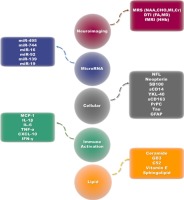Progress in Neurobiology ( IF 6.7 ) Pub Date : 2016-04-12 , DOI: 10.1016/j.pneurobio.2016.04.003 Pejman Rahimian 1 , Johnny J He 1

|
HIV infection often causes neurological symptoms including cognitive and motor dysfunction, which have been collectively termed HIV/neuroAIDS. Neuropsychological assessment and clinical symptoms have been the primary diagnostic criteria for HIV/neuroAIDS, even for the mild cognitive and motor disorder, the most prevalent form of HIV/neuroAIDS in the era of combination antiretroviral therapy. Those performance-based assessments and symptoms are generally descriptive and do not have the sensitivity and specificity to monitor the diagnosis, progression, and treatment response of the disease when compared to objective and quantitative laboratory-based biological markers, or biomarkers. In addition, effects of demographics and comorbidities such as substance abuse, psychiatric disease, nutritional deficiencies, and co-infection on HIV/neuroAIDS could be more readily determined using biomarkers than using neuropsychological assessment and clinical symptoms. Thus, there have been great efforts in identification of HIV/neuroAIDS biomarkers over the past two decades. The need for reliable biomarkers of HIV/neuroAIDS is expected to increase as the HIV-infected population ages and their vulnerability to neurodegenerative diseases, particularly Alzheimer’s disease increases. Currently, three classes of HIV/neuroAIDS biomarkers are being pursued to establish objective laboratory-based definitions of HIV-associated neurologic injury: cerebrospinal fluid biomarkers, blood biomarkers, and neuroimaging biomarkers. In this review, we will focus on the current knowledge in the field of HIV/neuroAIDS biomarker discovery.
中文翻译:

HIV/神经艾滋病生物标志物
HIV 感染通常会引起神经系统症状,包括认知和运动功能障碍,统称为 HIV/神经艾滋病。神经心理学评估和临床症状一直是艾滋病毒/神经艾滋病的主要诊断标准,甚至对于轻度认知和运动障碍(联合抗逆转录病毒治疗时代艾滋病毒/神经艾滋病最常见的形式)也是如此。与客观和定量的基于实验室的生物标志物或生物标志物相比,这些基于表现的评估和症状通常是描述性的,不具有监测疾病的诊断、进展和治疗反应的敏感性和特异性。此外,使用生物标志物比使用神经心理学评估和临床症状更容易确定人口统计学和合并症(例如药物滥用、精神疾病、营养缺乏和合并感染)对艾滋病毒/神经艾滋病的影响。因此,过去二十年来,人们在识别艾滋病毒/神经艾滋病生物标志物方面付出了巨大的努力。随着艾滋病毒感染人群的老龄化及其对神经退行性疾病(尤其是阿尔茨海默病)的脆弱性的增加,对艾滋病毒/神经艾滋病的可靠生物标志物的需求预计也会增加。目前,正在研究三类 HIV/神经艾滋病生物标志物,以建立基于实验室的客观的 HIV 相关神经损伤定义:脑脊液生物标志物、血液生物标志物和神经影像生物标志物。在这篇综述中,我们将重点关注艾滋病毒/神经艾滋病生物标志物发现领域的当前知识。











































 京公网安备 11010802027423号
京公网安备 11010802027423号